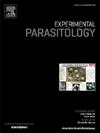Transfection of bovine cells with synthetic mRNA to induce expression of functional antibodies against Tritrichomonas foetus surface antigen TF1.17
IF 1.4
4区 医学
Q3 PARASITOLOGY
引用次数: 0
Abstract
Bovine trichomonosis is caused by the urogenital parasite Tritrichomonas foetus (T. foetus). In the United States, approved therapies are lacking, and management is limited to culling infected bulls. Preputial therapy with synthetic mRNA could lead to effective new treatments. We developed synthetic mRNA encoding bovine IgG1 against two epitopes of the T. foetus cell surface antigen TF1.17 and used the mRNA to transfect bovine cells in vitro. Transfected cells expressed membrane anchored or secreted versions of the antibodies with a NanoLuciferase (NanoLuc) reporter molecule fused to each light chain. Luminescence in cells and supernatants collected 24 and 48 h post-transfection confirmed the production of anti-TF1.17 and was significantly higher than in non-transfected controls (p < 0.05). Anti-TF1.17 bound to live parasites as indicated by significantly higher luminescence following treatment with 24 and 48 h post-transfection supernatants compared to transfection controls (p = 0.001). Treatment of T. foetus with concentrated anti-TF1.17 antibody decreased parasite viability. When T. foetus were added to mRNA transfected kidney cells 48 h post transfection, cytopathic effects of the parasites were reduced following 24 h of co-culture with cells producing anti-TF1.17 as compared to controls (p < 0.05). To our knowledge, this is the first use of mRNA transfection of bovine cells to induce the expression of antibodies that can bind to T. foetus, decrease their viability and their cytopathic effects on host cells. This work forms the basis for the development of novel mRNA-mediated approaches to treat or prevent bovine trichomonosis.

用合成mRNA转染牛细胞诱导抗三毛单胞菌胎儿表面抗原TF1.17的功能抗体的表达。
牛毛滴虫病是由泌尿生殖道寄生虫胎儿毛滴虫(T. foetus)引起。在美国,缺乏经批准的治疗方法,管理仅限于剔除受感染的公牛。用合成mRNA进行包皮治疗可能会产生有效的新疗法。我们合成了编码牛IgG1对抗T.胎细胞表面抗原TF1.17两个表位的mRNA,并利用该mRNA在体外转染牛细胞。转染后的细胞表达膜锚定或分泌型抗体,每个轻链上融合了纳米荧光素酶(NanoLuc)报告分子。转染后24和48 h收集的细胞和上清液的发光证实了抗tf1.17的产生,并且显著高于未转染的对照组(p
本文章由计算机程序翻译,如有差异,请以英文原文为准。
求助全文
约1分钟内获得全文
求助全文
来源期刊

Experimental parasitology
医学-寄生虫学
CiteScore
3.10
自引率
4.80%
发文量
160
审稿时长
3 months
期刊介绍:
Experimental Parasitology emphasizes modern approaches to parasitology, including molecular biology and immunology. The journal features original research papers on the physiological, metabolic, immunologic, biochemical, nutritional, and chemotherapeutic aspects of parasites and host-parasite relationships.
 求助内容:
求助内容: 应助结果提醒方式:
应助结果提醒方式:


